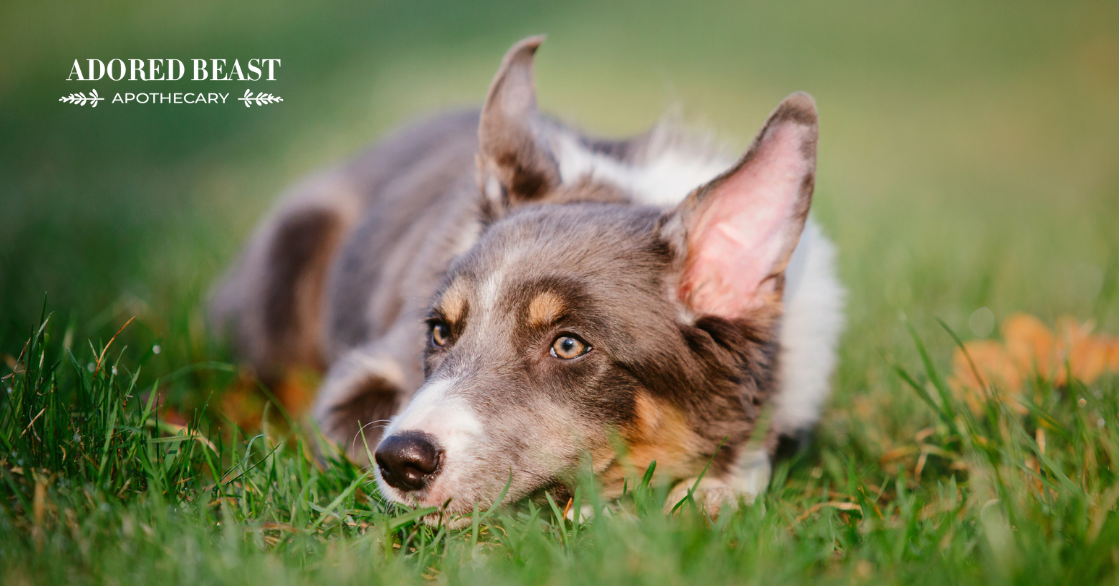A few years ago, when one of our family dogs, Loki, was about 2, she started to have seizures. Thankfully, they were (and continue to be), incredibly infrequent. But our vet did confirm that it was very likely epilepsy. And so we dug into the research (and of course I went right to ABA founder Julie Anne Lee for help).
Epilepsy in dogs is not overly common – estimates suggest 0.75% to 5% of the canine population has it. But for those pets parents of dogs with it, it can be a challenge.
So, what causes epilepsy in our canine companions? Are there certain genetic traits that make it more common in some breeds than others? Are there common triggers?
And how can you support your animal if they have it?
We’ve learned a lot since Loki’s diagnosis, and I believe that knowledge has given us a much better handle on the seizures. So I want to share what we’ve learned and help you help your animal. While witnessing your beloved pet experience a seizure can be distressing, understanding this condition and exploring natural management strategies can help improve your dog’s life.
What is Canine Epilepsy?
Epilepsy is a neurological condition that affects dogs just as it does humans. It’s a complex disorder characterized by recurrent seizures, which are sudden bursts of abnormal electrical activity in the brain. It can be classified as generalized when the entire brain is affected (typically with generalized muscle contractions), and focal when it is limited to only one area of the brain (movement of part of the body only).
There are 3 different types of epilepsy in dogs:
- Idiopathic Epilepsy: This is the most common form and typically has no identifiable cause. It often appears in dogs between 6 months and 6 years old.
- Symptomatic Epilepsy: This type is associated with an identifiable cause such as head trauma, brain tumors, or infections affecting the brain.
- Cluster Seizures: Dogs may experience multiple seizures in a short period, known as cluster seizures.
When a dog has a seizure, the symptoms can vary. They can last anywhere from a few seconds to a few minutes, during which time your dog may shake, have involuntary movements or facial twitching, with or without loss of consciousness. They may lose their balance or struggle to stand, they may fall over, convulse, or have uncontrolled urination and/or defecation.
Thankfully, despite their very dramatic appearance, it is agreed upon that they are not painful. Still, your dog may seem confused or anxious when they come out of one (Loki does – she gets clingy and sucky).
Are All Seizures Epilepsy?
Not all seizures are related to epilepsy. Seizures can be caused by various factors such as toxins, low blood sugar, or electrolyte imbalances. If the seizures happen more than once, it’s a good idea (and your trusted veterinarian will likely suggest this) to keep careful track of them. Note the time, duration, behaviour, and any and all potential triggers (what was your dog doing before the seizures). This will help your vet determine if it could be epilepsy.
[RELATED] Seizures in Dogs: Types, Causes, and Natural Approaches
Causes of Epilepsy in Dogs
The exact causes of epilepsy in dogs remain unclear, but genetics likely play a significant role. And certain breeds are predisposed, including:
- Labrador Retrievers
- German Shepherds
- Golden Retrievers
- Beagles
- Collies
- Poodles
- Irish Setters
- Dachshunds
Other potential triggers or contributors include:
- Brain abnormalities
- Metabolic disorders – hypothyroidism is a huge one!
- Exposure to toxins, including topical flea and tick medicines (it says this right on the label!!) and many vaccines, with a higher incidence noted with rabies. If possible, only do titres. Talk to your veterinarian about your concerns and the known risks for epileptic dogs.
- Infections affecting the brain – you want to protect the gut-brain axis and protect the gut (and the immune system) to help it better fight infection
- Environmental factors
- Stress and anxiety
What to Do When Your Dog Has a Seizure
As we mentioned, thankfully seizures are not painful, but you do want to follow certain steps when they occur.
- The most important thing to do is to remain calm. You don’t want to freak out and further stress out your animal.
- Ensure they are in a safe space where they can’t hurt themselves. For example, you don’t want them near stairs, or anywhere that a fall could result in injury.
- Speak calmly to them, and try to avoid touching their head or mouth. Dogs can’t swallow their tongues during a seizure, so don’t put your hand near their mouth.
- Keep them cool. Cool air (from a fan, for example) can help – seizures usually make dogs warm.
- Once the seizure is over, continue speaking softly to help them feel safe.
- Feed your dog right away. They’ll be really hungry because seizures take a lot of energy! Give small amounts or their regular food, slowly.
If this is the first time your dog has had a seizure, it’s a good idea to reach out to your vet. Since seizures can be caused by many different things, you want to get their advice and get a thorough exam done if they deem it necessary.
Natural Protection & Management
Regular practice used to be that any incidence of seizures or epilepsy would prompt a vet to prescribe medication. Thankfully, we’ve learned a lot, and most vets are far more conservative, only prescribing meds if the seizures are frequent (more than once a month). Follow their directions, and if you can, work with an internal medicine specialist.
If your dog has been diagnosed with epilepsy, you may want to explore natural methods, either as the sole protection (if your vet hasn’t prescribed anything) or as a complement to conventional treatment.
Here are some of the things we learned and implemented with Loki (if they were not already part of her regular lifestyle):
- Diet: You want to feed the highest-quality food you can. Opt for a balanced, fresh food diet, with plenty of natural sources of vitamins and minerals. Avoid potential allergens or additives.
- Supplements: Certain supplements may support neurological health. These include omega-3 fatty acids, antioxidants (like vitamin E or C), MCT oil, lion’s mane mushrooms, and herbal remedies like valerian root or chamomile. If your vet prescribes medication, it’s also really important to support the liver!
- Stress Reduction: Minimize stressors in your dog’s environment. Provide a calm and predictable routine, and consider activities like massage or acupuncture.
- Regular Exercise: Maintain a consistent exercise routine to help reduce anxiety and promote overall health. Exercise is really important for overall health – both physical and mental. The brain really does benefit!
- Avoid Triggers: Identify and minimize potential triggers such as exposure to toxins, excessive heat, or flashing lights. For example, Loki has very mild separation anxiety, and if we don’t follow her established routine, it can bring about a seizure. Thankfully, because we’ve established this trigger, we are able to manage it!!
- Disconnect from WiFI: unplug your modem at night (really anything that’s electromagnetic) to give your animal (and their brain in particular) a good break. And don’t let your animal sleep close to the modem (but don’t block their access to you!!). On this same note, batteries in cars – if you’re traveling, try to keep your pet away from where the battery is housed.
- Natural Remedies: There’s a ton of research into CBD oil for dogs with epilepsy – it has shown promise in reducing seizure frequency in dogs (Loki gets hers every day). Arnica, aconite, and belladonna are really helpful after a seizure. Find a homeopath if you have questions. (Keep Your Go 2 on hand!!).
We’re very lucky with Loki – as I said, her seizures are very infrequent. But that doesn’t mean they’re not nerve-racking every time they do happen. Epilepsy in dogs can seem really scary, but with the right approach, you can help manage and improve your dog’s well-being. Always work closely with your holistic veterinarian to come up with a plan that fits your dog’s specific needs. With dedication and care, you can support your furry friend in living a happy and comfortable life despite epilepsy.












